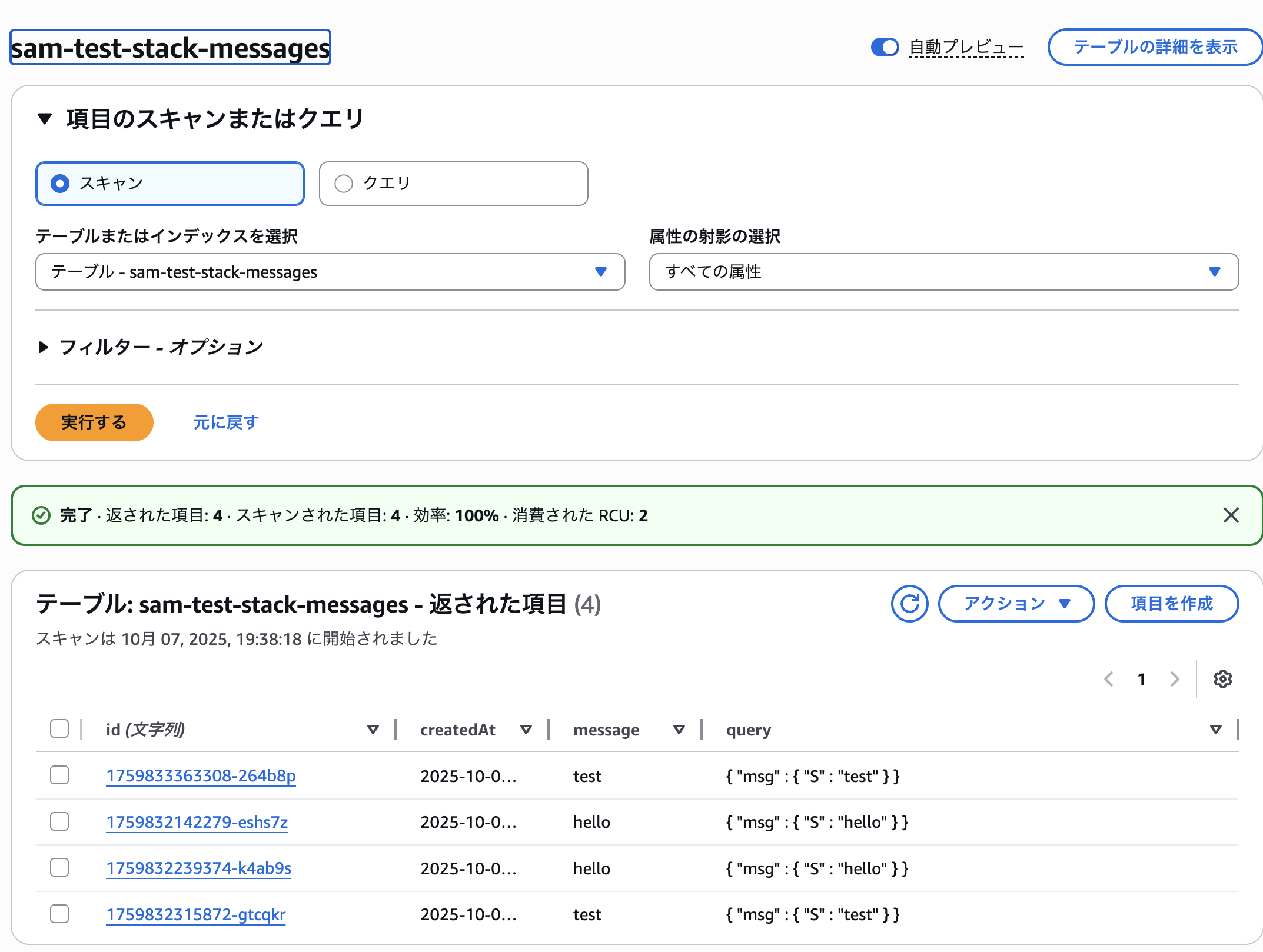AWS SAMとは
AWS SAM(Serverless Application Model)とは、サーバレス構成のシステムを、より簡単に構築するためのフレームワークとツール群の総称です。
CloudFormationをベースとしてより簡単にAPI GatewayやLambdaをデプロイできるようになっています。
YAMLの記述量も直接CloudFormationを記載するよりも抑えることができます。
SAMの説明については、tech4anyoneさんが記載されているこちらの記事などが参考になると思います。
ちなみに前回の検証でKiroの無料枠を使い切ったので、
今回はChatGPTさんのお世話になりながら作成しました。
今回の目的
X-RayやApplication Signalsなどシステムのオブザーバビリティの検証をしようと思ったのですが、
元々インフラ家なので、あんまり凝ったアプリが作成できません。
簡単に検証環境を作ることを目的として、AWS SAMを採用しました。
最終目標は自動計装の検証となります。
今回はその前段となるサンプルアプリケーションを構築したいと思います。
X-RayやAppication Signalsについて追々記事にしたいと思います。
※ 現時点でX-RayやApplication SignalsとAWS SAMの親和性・統合する難易度などは、何も考えていません。。。
とりあえずSAMのお勉強も兼ねてサンプルアプリを構築します。
サンプルアプリの構成
上述した通り、複数のLambdaやそのバックエンドのサービスを横断的に自動計装できるか?を後々確かめたいので、下記の構成としました。
- 作成するLambdaは下記の3つ
-
- クライアントからのリクエストを受け取って、SQSにメッセージを格納するAPI
-
- SQSからメッセージを取り出してDynamoDBに格納するLambda
-
- クライアントからのリクエストにより、DynamoDBをスキャンして返却するAPI
AWS 開発環境の構築
あまり詳しくは解説しません。前提ツールの確認と、AWS SAMのインストール手順になります。
Python3
Python3が必要です。インストールされているか下記コマンドで確認してください。
% python3 --version
Python 3.9.6
バージョンが表示されない場合は、下記サイトからインストーラをダウンロードインストールしてください。
(homebrewからインストールする方法もありますが、筆者環境にhomebrewがセットアップされていないため)
AWS CLI
AWS CLI V2以降が推奨です。こちらも下記コマンドで確認。
% aws --version
aws-cli/2.27.50 Python/3.13.4 Darwin/25.0.0 exe/x86_64
AWS公式サイトをご参考にセットアップしてください。
aws configureの設定などもお忘れなく。
Docker Desktop
Docker環境が必要になります。
筆者はMac上のDocker Desktopを利用しています。
% docker --version
Docker version 28.4.0, build d8eb465
こちらも公式サイトからダウンロードしてインストール。
AWS SAM
いよいよAWS SAMのセットアップです。
AWS公式からインストーラをダウンロードします。
こちらも一般的なpkgファイルを用いたインストール方法のため説明は省きます。
下記コマンドを実行してバージョンが表示されれば成功です。
% sam --version
SAM CLI, version 1.144.0
サンプルアプリの作成
サンプルアプリを配置していきます。
ディレクトリ構成
下記ディレクトリを作成し、各ファイルを格納していきます。
全体図
sam-test/
├── template.yaml
├── package.json
├── package-lock.json
├── node_modules/
└── src/
├── enqueue/index.js
├── worker/index.js
└── query/index.js
各要素の説明
template.yaml
SAM本体。SQS・DynamoDB・HttpApi・Lambdaオーソライザーのすべてを定義。
node_modules
npmで依存コンポーネントをルート直下にインストール。
src/enqueue/index.js
API Gateway経由でリクエストを受け、SQSにメッセージを格納するLambdaの本体。
src/worker/index.js
SQSイベントをトリガーにDynamoDBへメッセージを保存するLambdaの本体。
src/query/index.js
DynamoDBをスキャンしてHTTPレスポンスで返却するLambdaの本体。
ディレクトリ作成
下記のコマンドで、必要なディレクトリを作成します。
% mkdir sam-test
% cd sam-test
% mkdir -p src/enqueue src/worker src/query
プロジェクトの初期化と依存パッケージのインストール
cd ..
npm init -y
npm i @aws-sdk/client-sqs @aws-sdk/client-dynamodb @aws-sdk/lib-dynamodb
ソース配置
ディレクトリ構成に従って、ファイルを格納します。
template.yaml
AWSTemplateFormatVersion: '2010-09-09'
Transform: AWS::Serverless-2016-10-31
Description: SQS -> Lambda -> DynamoDB (no authorizer, public API)
Globals:
Function:
Runtime: nodejs20.x
Timeout: 10
MemorySize: 128
Architectures: [x86_64]
Tracing: Active
CodeUri: .
Environment:
Variables:
TABLE_NAME: !Ref MessagesTable
QUEUE_URL: !Ref InboundQueue
Resources:
# ---------- SQS ----------
InboundDLQ:
Type: AWS::SQS::Queue
Properties:
QueueName: !Sub '${AWS::StackName}-dlq'
MessageRetentionPeriod: 1209600
InboundQueue:
Type: AWS::SQS::Queue
Properties:
QueueName: !Sub '${AWS::StackName}-queue'
VisibilityTimeout: 30
RedrivePolicy:
deadLetterTargetArn: !GetAtt InboundDLQ.Arn
maxReceiveCount: 3
# ---------- DynamoDB ----------
MessagesTable:
Type: AWS::DynamoDB::Table
Properties:
TableName: !Sub '${AWS::StackName}-messages'
BillingMode: PAY_PER_REQUEST
AttributeDefinitions:
- AttributeName: id
AttributeType: S
- AttributeName: createdAt
AttributeType: S
KeySchema:
- AttributeName: id
KeyType: HASH
GlobalSecondaryIndexes:
- IndexName: createdAt-index
KeySchema:
- AttributeName: createdAt
KeyType: HASH
Projection:
ProjectionType: ALL
# ---------- HTTP API ----------
HttpApi:
Type: AWS::Serverless::HttpApi
Properties:
StageName: prod
CorsConfiguration:
AllowOrigins: ['*']
AllowMethods: ['GET']
AllowHeaders: ['*']
# ---------- ① Enqueue ----------
EnqueueFunction:
Type: AWS::Serverless::Function
Properties:
Handler: src/enqueue/index.handler
Policies:
- AWSLambdaBasicExecutionRole
- SQSSendMessagePolicy:
QueueName: !GetAtt InboundQueue.QueueName
Events:
EnqueueGet:
Type: HttpApi
Properties:
ApiId: !Ref HttpApi
Path: /enqueue
Method: GET
# ---------- ② Worker ----------
WorkerFunction:
Type: AWS::Serverless::Function
Properties:
Handler: src/worker/index.handler
Policies:
- AWSLambdaBasicExecutionRole
- DynamoDBCrudPolicy:
TableName: !Ref MessagesTable
Events:
FromSqs:
Type: SQS
Properties:
Queue: !GetAtt InboundQueue.Arn
BatchSize: 10
MaximumBatchingWindowInSeconds: 5
# ---------- ③ Query ----------
QueryFunction:
Type: AWS::Serverless::Function
Properties:
Handler: src/query/index.handler
Policies:
- AWSLambdaBasicExecutionRole
- DynamoDBReadPolicy:
TableName: !Ref MessagesTable
Events:
ListItems:
Type: HttpApi
Properties:
ApiId: !Ref HttpApi
Path: /items
Method: GET
Outputs:
HttpApiUrl:
Value: !Sub 'https://${HttpApi}.execute-api.${AWS::Region}.amazonaws.com/prod'
Description: Base URL of the HttpApi
QueueUrl:
Value: !Ref InboundQueue
TableName:
Value: !Ref MessagesTable
src/enqueue/index.js
const { SQSClient, SendMessageCommand } = require("@aws-sdk/client-sqs");
const sqs = new SQSClient();
exports.handler = async (event) => {
try {
const qs = event.queryStringParameters || {};
const msg = qs.msg ?? "";
const payload = {
id: `${Date.now()}-${Math.random().toString(36).slice(2, 8)}`,
message: msg,
query: qs,
createdAt: new Date().toISOString(),
};
await sqs.send(new SendMessageCommand({
QueueUrl: process.env.QUEUE_URL,
MessageBody: JSON.stringify(payload),
}));
return {
statusCode: 200,
headers: { "Content-Type": "application/json" },
body: JSON.stringify({ status: "enqueued", queueUrl: process.env.QUEUE_URL, item: payload }),
};
} catch (err) {
console.error("Enqueue error:", err);
return { statusCode: 500, body: JSON.stringify({ error: "Failed to enqueue" }) };
}
};
src/worker/index.js
const { DynamoDBClient } = require("@aws-sdk/client-dynamodb");
const { DynamoDBDocumentClient, PutCommand } = require("@aws-sdk/lib-dynamodb");
const ddbDoc = DynamoDBDocumentClient.from(new DynamoDBClient());
exports.handler = async (event) => {
try {
const puts = [];
for (const record of event.Records ?? []) {
const body = JSON.parse(record.body || "{}");
const item = {
id: body.id,
message: body.message ?? null,
query: body.query ?? {},
createdAt: body.createdAt ?? new Date().toISOString(),
};
puts.push(ddbDoc.send(new PutCommand({ TableName: process.env.TABLE_NAME, Item: item })));
}
await Promise.all(puts);
return { ok: true, stored: puts.length };
} catch (err) {
console.error("Worker error:", err);
throw err; // SQSの再試行/ DLQへ
}
};
src/query/index.js
const { DynamoDBClient } = require("@aws-sdk/client-dynamodb");
const { DynamoDBDocumentClient, ScanCommand } = require("@aws-sdk/lib-dynamodb");
const ddbDoc = DynamoDBDocumentClient.from(new DynamoDBClient());
exports.handler = async (event) => {
try {
const qs = event.queryStringParameters || {};
const limit = Math.min(parseInt(qs.limit || "25", 10), 100);
const data = await ddbDoc.send(new ScanCommand({
TableName: process.env.TABLE_NAME,
Limit: limit,
}));
return {
statusCode: 200,
headers: { "Content-Type": "application/json" },
body: JSON.stringify({
count: data.Items?.length || 0,
items: data.Items || [],
lastEvaluatedKey: data.LastEvaluatedKey || null,
}),
};
} catch (err) {
console.error("Query error:", err);
return { statusCode: 500, body: JSON.stringify({ error: "Failed to scan DynamoDB" }) };
}
};
buildしてみる
ソースの配置が完了したら、buildしてみましょう。
% sam build
Building codeuri: sam-test runtime: nodejs20.x architecture: x86_64 functions: EnqueueFunction, WorkerFunction, QueryFunction
Running NodejsNpmBuilder:NpmPack
Running NodejsNpmBuilder:CopyNpmrcAndLockfile
Running NodejsNpmBuilder:CopySource
Running NodejsNpmBuilder:NpmInstall
Running NodejsNpmBuilder:NpmTest
Running NodejsNpmBuilder:CleanUpNpmrc
Running NodejsNpmBuilder:LockfileCleanUp
Build Succeeded
Built Artifacts : .aws-sam/build
Built Template : .aws-sam/build/template.yaml
Commands you can use next
=========================
[*] Validate SAM template: sam validate
[*] Invoke Function: sam local invoke
[*] Test Function in the Cloud: sam sync --stack-name {{stack-name}} --watch
[*] Deploy: sam deploy --guided
成功したようです。
いざ!デプロイ!
下記コマンドでAWS環境にデプロイします。
sam deploy \
--stack-name sam-test-stack \
--region ap-northeast-1 \
--capabilities CAPABILITY_IAM \
--no-confirm-changeset \
--resolve-s3
途中省略しますが、下記の通り成功したっぽい。
CloudFormation outputs from deployed stack
----------------------------------------------------------------------------------------------------------------------------------------------------------------------
Outputs
----------------------------------------------------------------------------------------------------------------------------------------------------------------------
Key TableName
Description -
Value sam-test-stack-messages
Key HttpApiUrl
Description Base URL of the HttpApi
Value https://**********.execute-api.ap-northeast-1.amazonaws.com/prod
Key QueueUrl
Description -
Value https://sqs.ap-northeast-1.amazonaws.com/************/sam-test-stack-queue
----------------------------------------------------------------------------------------------------------------------------------------------------------------------
Successfully created/updated stack - sam-test-stack in ap-northeast-1
テスト
実際に叩いてみます。
キューに突っ込む
curl -sS "APIのURL/enqueue?msg=test"
結果は下記の通り登録されたようです。
{"status":"enqueued","queueUrl":"https://sqs.ap-northeast-1.amazonaws.com/************/sam-test-stack-queue","item":{"id":"*************-264b8p","message":"test","query":{"msg":"test"},"createdAt":"2025-10-07T10:36:03.312Z"}}%
SQSからDynamoDBに登録
数秒まつとDynamoDBに登録されました。
アイテム検索
DynamoDBをスキャンした結果を表示してみます。
curl -sS "APIのURL/items?limit=10" | jq .
何度かテストしたので複数メッセージ表示されます。
{
"count": 4,
"items": [
{
"createdAt": "2025-10-07T10:36:03.312Z",
"message": "test",
"id": "*************-264b8p",
"query": {
"msg": "test"
}
},
{
"createdAt": "2025-10-07T10:15:42.291Z",
"message": "hello",
"id": "*************-eshs7z",
"query": {
"msg": "hello"
}
},
{
"createdAt": "2025-10-07T10:17:19.374Z",
"message": "hello",
"id": "*************-k4ab9s",
"query": {
"msg": "hello"
}
},
{
"createdAt": "2025-10-07T10:18:35.872Z",
"message": "test",
"id": "*************-gtcqkr",
"query": {
"msg": "test"
}
}
],
"lastEvaluatedKey": null
}
お掃除
検証が終わったので下記コマンドで全てのリソースを削除します。
sam delete
Stack名を聞かれるので、sam-test-stackと入力
まとめ
とりあえずSAMの概要の検証はできました。
